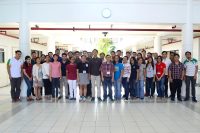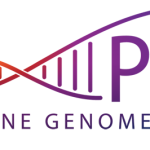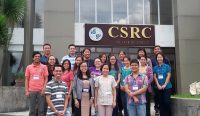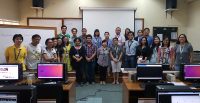Held usually at 3:30pm on Fridays, TGIF discussions are informal talks on current scientific topics and events.

Virus-host immune system modeling
To bring together a group of Filipino scientists who are active or plan on actively working in the research area of virus-host immune modeling, in an environment that is conducive to open and stimulating discussions.

Comparative genomics of cellulolytic shipworm symbionts
Shipworms are marine bivalves that live and feed on wood. These bivalves, like most xylophagous and herbivorous animals, rely on bacterial symbionts to digest the recalcitrant lignocellulose component of plants. What’s unusual about shipworms is that bacterial symbionts are housed intracellularly in the specialized cells in the gills, therefore are not in direct contact with the ingested food particles.

Introduction to RNA-Seq processing and analysis
A 2-day workshop provided by Dr. Nelzo Ereful, Post-doctoral Researcher (Bioinformatics) at the National Institute of Agricultural Botany, Cambridge, UK

TGIF Seminar: July 22, 2016
Held usually at 3:30pm on Fridays, TGIF discussions are informal talks on current scientific topics and events.

TGIF Seminar: July 15, 2016
On C4 Rice, the PhilRice NGS Experience, and an exit report on the “Life and Times of DSCF”

Assembly, Annotation, Variant Calling, and Phylogenetic Analysis of Bacterial Genomes (June 2016)
Assembly, Annotation, Variant Calling, and Phylogenetic Analysis of Bacterial Genomes (June 2016) Workshop by the Core Facility for Bioinformatics

Signaling-mediated epigenetic silencing of tumor suppressor genes in ovarian cancer
Aberrant TGFβ signaling pathway may alter the expression of down-stream targets and promotes ovarian carcinogenesis. However, the mechanism of this impairment is not fully understood. By ChIP-chip and expression microarray, we have previously identified several SMAD4 targets in an immortalized ovarian surface epithelial cells. Bioinformatic analyses identified several SMAD transcriptional modules that predict expression changes after TGF-β activation. Knockdown of SMAD4 in CP70 ovarian cancer cells showed an increase in promoter methylation in some of those SMAD4 targets as demonstrated by sequencing-based analysis.

Dr. Zeni Magbanua: My Work on Genomics
Held usually at 3:30pm on Fridays, TGIF discussions are informal talks on current scientific topics and events. The gathering is sponsored by the PGC, NIMBB (National Institute of Molecular Biology & Biotechnology) at UP Diliman, and the IB (Institute of Biology) at UP Diliman.

Genome Assembly, Annotation and Variant Calling Training and Workshop (June 2016)
Genome Assembly, Annotation and Variant Calling Training and Workshop (June 2016) by Core Facility for Bioinformatics

